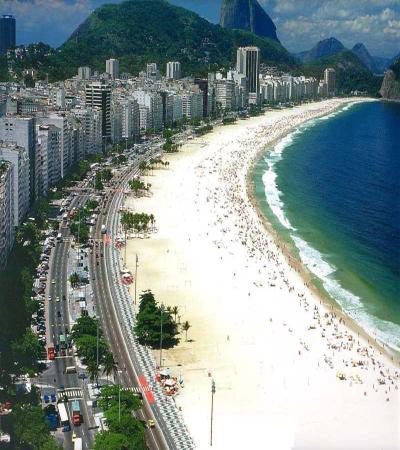http://www.riodejaneiro.com/v/geography/
Location
Geographical Coordinates: 22°54′S 43°12′W
Location
Rio de Janeiro is mainly made up of seas, mountains and forests. This diversity adds to its outstanding beauty. Though Rio is largely a metro city, it has developed around the Tijuca Forest which is the largest urban forest in the world.
The city is geographically located at 22 degrees, 54 minutes south latitude and 43 degrees 12 minutes west longitude. Rio City is also the capital of the Rio de Janeiro state which lies in the south eastern region of Brazil. To the south of the city lies the Atlantic Ocean and to the east Guanabara Bay (Baía de Guanabara). The west is covered by Sepetiba Bay (Baía de Sepetiba).
17 other municipalities come together to form the Rio de Janeiro Metropolitan area. These include Duque de Caxias, Itaguaí, Mangaratiba, Nilópolis, Nova Iguaçu, São Gonçalo, Itaboraí, Magé, Maricá, Niterói, Paracambi, Petrópolis, São João de Meriti, Japeri, Queimados, Belford Roxo, Guapimirim.
Rio de Janeiro covers an area of 1,255,3km² which includes islands and continental waters. It measures 70km from east to west and 44km from north to south. The municipality includes 32 Administrative Regions along with 159 districts.
The main river that flows through Rio is the Cabuçu or Piraquê. Rio region also includes a few lagoons like Jacarepaguá Lagoon, Marapendi Lagoon, Lagoinha and the Rodrigo de Freitas Lagoon. Most of them are scenic and have a good infrastructure for tourists such as hotels, restaurants and facilities for outdoor activities.
Rio has a long coastline which measures 246,22 km long. It is divided into three divisions: Guanabara Bay (Baía de Guanabara), the Atlantic Ocean and Sepetiba Bay (Baía de Sepetiba).
Out of the 1,255,3km² area covered by Rio, 37km² is covered by islands. The main islands include Laje; Villegaignon; Cobras; Fiscal; Enxadas in the Guanabara Bay, Cotunduba, Arquipélago das Cagarras, Rasa, Arquipélago da Redonda, Arquipélago das Tijucas, Palmas e Peças and Frade in the Atlantic Ocean and the Bom Jardim; Nova; Cavado; Guaraquessaba; Tatu; Pescaria in the Sepetiba Bay.
Climate
Rio has a tropical climate due to the forests surrounding it. Most of the year, the climate is warm and humid with exceptions due to altitude, vegetation and closeness to the ocean. Occasionally temperatures can reach to a high of 40°C but mostly they hover around 30°C. Regions which are near the sea are somewhat cooler due to the ocean winds.
Average annual rainfall varies from 1,200 to 2,800 mm. During the hot summer months, the evenings are much cooler due to heavy and rapid rains, making the temperature bearable.
Temperature In Rio de Janeiro
Average temperature per month in Rio de Janeiro:
| Month | High°C | Low°C | Month | High°C | Low°C |
| Jan | 29 | 23 | July | 24 | 18 |
| Feb | 28 | 23 | Aug | 23 | 17 |
| Mar | 28 | 23 | Sep | 24 | 18 |
| Apr | 27 | 22 | Oct | 25 | 20 |
| May | 26 | 21 | Nov | 27 | 21 |
| June | 25 | 19 | Dec | 28 | 22 |



No comments:
Post a Comment